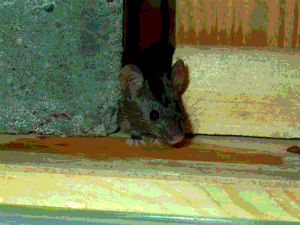Diseases carried by mice
Online Biology Dictionary
|
|

|
Ways diseases carried by mice are passed to humans:- by biting- by infecting human food with droppings - by infecting human food with urine - by infecting skin wounds with urine - via airborne dust from dried droppings - indirectly, by blood-sucking insects - indirectly, by mites - indirectly, by means of cats and dogs - by dying in a water source drunk by humans |
|
|
|
|
|
|
|
|
Diseases carried by mice include, but are not limited too, the following:
Bubonic plague - Mice are not infected with plague as often as rats, but infections do occur. This disease is spread to humans by fleas. Plague is usually fatal within a few days of infection. It is present in rodents throughout the western United States, and in many other parts of the world (worldwide map showing areas where plague exists >>).
Salmonella - Mice and rats are both frequent carriers. Spreads to humans by contact with mouse droppings, especially through consumption of contaminated food. Causes serious, sometimes fatal gastroenteritis. Household pets are also frequently infected with Salmonella by this means and often die as a result.
Murine Typhus (typhus transmitted from mice via flea bite) - This disease is treatable with antibiotics, but can cause death in elderly or infirm individuals. Symptoms include vomiting, fever, headache, myalgia, and cough.
Leptospirosis - Rats and mice are both carriers of this potentially fatal disease. More about leptospirosis →
Lymphocytic Chorio-meningitis (LCM) - A rodent-borne viral infectious disease presenting as aseptic meningitis (inflammation of the membrane surrounding the brain and spinal cord) and/or encephalitis (inflammation of the brain itself). Usually, LCM is not fatal (mortality is less than 1%).
Rat-bite Fever - Fatal in 10 percent of untreated cases. Usually contracted from rats, but infection can also occur from mice. The bacterium causing this disease enters the body through bites, as its name suggests, or from urine contaminating either food or preexisting skin wounds.
Hantavirus Pulmonary Syndrome (HPS) - Infection with hantavirus can progress to HPS, another of the diseases carried by mice. HPS is often fatal. People become infected through contact with rodents infected with hantavirus or with their urine and droppings. The Sin Nombre hantavirus, first recognized in 1993, is one of several New World hantaviruses circulating in the US. Old World hantaviruses, found in Asia, can cause Hemorrhagic Fever with Renal Syndrome (HFRS). The following four rodents are the primary carriers of hantavirus in the US: Deer Mouse (Peromyscus maniculatus), Cotton Rat (Sigmodon hispidus), Rice Rat (Oryzomys palustris), and White-footed mouse (Peromyscus leucopus).
Tapeworms - Mice host small tapeworms of the genus Hymenolepis that can spread to humans who eat foods contaminated with mouse droppings (or when hands are merely dirtied by droppings and not washed before meals). These parasites hatch out in the gut where they grow and reproduce. More about mouse tapeworms >>
More about diseases carried by mice >>
CDC: Diseases directly transmitted by rodents >>
Diseases Carried by Mice - © Macroevolution.net
Most shared on Macroevolution.net:
Human Origins: Are we hybrids?
On the Origins of New Forms of Life
Mammalian Hybrids
Cat-rabbit Hybrids: Fact or fiction?
Famous Biologists
Dog-cow Hybrids
Prothero: A Rebuttal
Branches of Biology
Dog-fox Hybrids